Keid, 40 Eridani (Omicron2 Eridani), is an orange main sequence star in a triple star system located 16.34 light-years away in the constellation Eridanus. With an apparent magnitude of 4.43, the star is visible to the unaided eye from areas without too much light pollution. It appears in the northern part of Eridanus and can be seen from most locations for at least part of the year. In Star Trek lore, 40 Eridani is the host star of the planet Vulcan.
Star system
40 Eridani is a triple star composed of an orange main sequence star (40 Eridani A), a white dwarf (40 Eridani B), and a red dwarf (40 Eridani C).
The primary component and the 40 Eridani BC pair have an orbital period of around 8,000 years and are separated by about 400 astronomical units (Earth-Sun distances). The dimmer pair, 40 Eridani B and C, orbit each other with a period of 230.30 years. Their orbit has an eccentricity of 0.410 and a semi-major axis of 35 astronomical units. The star system can be observed in a small telescope.
The primary star, formally known as Keid, has the stellar classification K0.5V. It shines at magnitude 4.43 from a distance of 16.340 light-years. The star has a mass of 0.78 solar masses and a radius of 0.812 solar radii. It has 45.7% of the Sun’s luminosity and a surface temperature of 5,072 K.
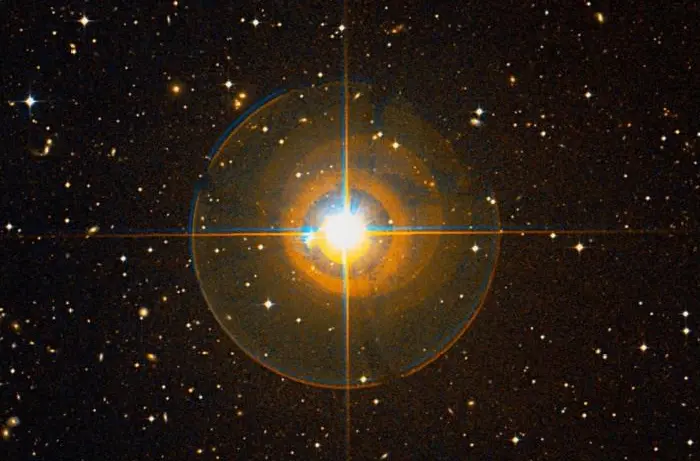
Keid (40 Eridani), image: Wikisky
40 Eridani A spins at 1.23 km/s and takes between 37 and 43 days to complete a rotation. The star is older than the Sun, with an estimated age of about 6.9 billion years.
The secondary component, 40 Eridani B, is a white dwarf of the spectral type DA2.9 or DA4. It lies 16.333 light-years away and has an apparent magnitude of 9.52. The stellar remnant has 57.3% of the Sun’s mass packed within a radius only 1.4% that of the Sun. It shines with 1.3% of the Sun’s luminosity and has an effective temperature of 16,500 K.
40 Eridani B is believed to have been the most massive of the three components when it was still on the main sequence. It evolved faster than its companions due to its higher mass, and expelled most of its mass before it became a white dwarf.
The faintest component, 40 Eridani C, is a red dwarf of the spectral type M4.5eV. It lies 16.353 light-years away and has an apparent magnitude of 11.17. The star is less massive than its white dwarf companion. It has a mass of 0.2036 solar masses and a radius 31% that of the Sun. With an effective temperature of 3,100 K, it shines with only 0.8% of the Sun’s luminosity. The red dwarf is believed to be around 5.6 billion years old.
40 Eridani C is classified as a flare star. Like many other red dwarfs, it experiences dramatic increases in brightness across the spectrum that last for a few minutes. The flares are believed to be similar to solar flares in that they are caused by the magnetic energy in the star’s atmosphere. Other nearby flare stars include Proxima Centauri in the constellation Centaurus, Wolf 359 in Leo, Barnard’s Star in Ophiuchus, and UV Ceti and BL Ceti in Cetus.
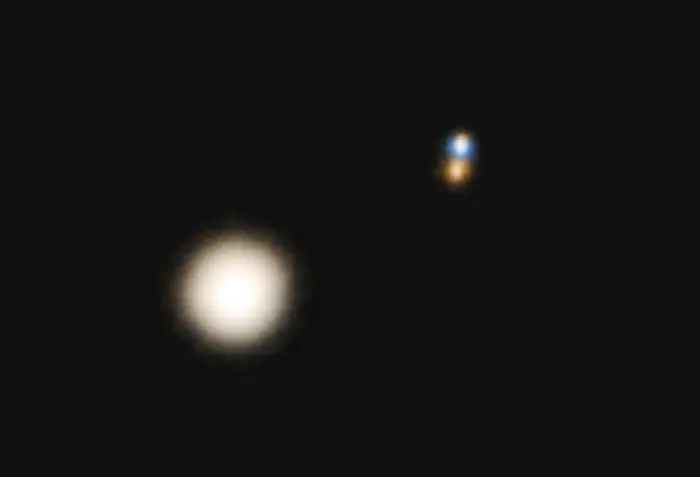
40 Eridani system, amateur photo taken by Mark Johnston. TEC160FL refractor, ZWO 183MC Pro camera. Stack of 30 1.5 second exposures. (CC BY-SA 4.0)
Planet
The 40 Eridani system does not host any confirmed exoplanets.
A radial velocity signal that may be interpreted as a planet orbiting the star was detected by Diaz et al. in 2018 based on observations with multiple instruments over a period of 16 years. The signal may also be explained as rotational activity of the star because it is close to the star’s rotation period. The team of astronomers could not confirm the nature of the signal.
The candidate planet, 40 Eridani b, would have an orbital period of 42.364 ± 0.015 days and a minimum mass of 6.92 ± 0.79 Earth masses (M⊕). It would orbit the host star at a distance of 0.215 ± 0.008 astronomical units.
A 2018 study concluded that the signal came from an orbiting planet and not from stellar activity. The study authors reported the detection of a super-Earth with a mass of 8.47 ± 0.47 M⊕. The candidate exoplanet was reported to have an orbital period of 42.38 ± 0.01 days. If it exists, the planet is not in the star’s habitable zone, but orbits much closer to 40 Eridani A and receives about nine times more stellar flux than Earth does from the Sun, even more than Mercury.
However, the presence of the planet remains disputed. A 2021 study explained the signal as a false positive, and a 2022 paper reported the cause of the signal as inconclusive. A study published in 2023 found that the signal was most likely due to the star’s rotation.
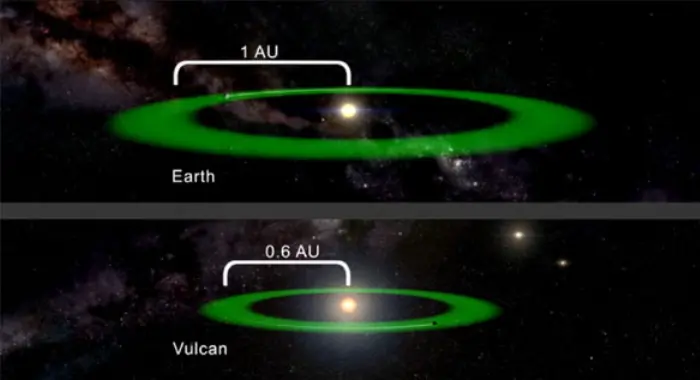
Comparison of the habitable zone of 40 Eridani with the habitable zone in our solar system. Image credit: NASA, Jet Propulsion Laboratory (JPL) (PD)
The habitable zone of the primary component, where liquid water may exist on a planet’s surface, is around 0.68 astronomical units (0.556 AU – 1.103 AU) from the star. A hypothetical planet at this distance would complete a revolution in 223 days and the parent star would appear 20% wider than Sun does from Earth.
40 Eridani B does not likely host any habitable planets. As the star expanded into a giant and cast away its outer layers, its radiation would have destroyed life on any potential planet. The current habitable zone is around 0.06 AU away from the stellar remnant, giving a hypothetical planet an orbital period of about 7.8 days.
40 Eridani C is not a likely candidate for Earth-like planets, either. The star experiences flares, which would not allow for life as it exists on Earth.
Facts
40 Eridani is well-known to science fiction fans because it is part of the Star Trek and Dune universes. In Star Trek lore, 40 Eridani A is the parent star of the planet Vulcan, the home world of Spock. In Frank Herbert’s Dune novels, the planet Richese, the hub of machine culture, orbits “Eridani A.”
Seen from a hypothetical planet in the Omicron2 Eridani system, the Sun would appear as a 3.4 magnitude star in the constellation Hercules, close to the border with Serpens.
An observer on a planet orbiting 40 Eridani A would see the components B and C as exceptionally bright stars, with visual magnitudes of -8 and -6. They would appear considerably brighter than Venus does from Earth.
With an apparent magnitude of 4.43, Keid is only the 31st brightest star in Eridanus.
The nearest neighbours of 40 Eridani are the red dwarf GJ 3323 (LP 656-38, 3.8 light-years away), the yellow-white dwarf HIP 15689 (4.4 ly), the red dwarf HD 36395 (BD-03 1123, 6.2 ly), the orange dwarf Epsilon Eridani (Ran, 6.4 ly), and the red dwarfs GJ 3379 (LTT 17897, 8.1 ly) and Teegarden’s Star (GJ 10393, 8.7 ly).
Omicron2 Eridani A was one of the top 100 target stars for NASA’s Terrestrial Planet Finder (TPF) project, along with Rigil Kentaurus (Alpha Centauri A) and Toliman (Alpha Centauri B) in the constellation Centaurus, Tau Ceti in Cetus, Achird (Eta Cassiopeiae) in Cassiopeia, Beta Hydri in Hydrus, Delta Pavonis in Pavo, Tabit (Pi3 Orionis) in Orion, Gamma Leporis in Lepus, and Ran (Epsilon Eridani) in Eridanus. Chara (Beta Canum Venaticorum) in Canes Venatici, Helvetios (51 Pegasi) in Pegasus, and Epsilon Indi in Indus were also on the list. The Terrestial Planet Finder was a proposed project to construct a system of space telescopes for finding extrasolar terrestrial planets. The project was cancelled in 2011.
Keid (Omicron2 Eridani) shares the Bayer designation Omicron Eridani with Beid (Omicron1 Eridani). The two points of light appear close in the night sky but are not physically related. Beid is a more evolved F-type giant star located 122 light-years away and merely appears in the same line of sight as Keid.
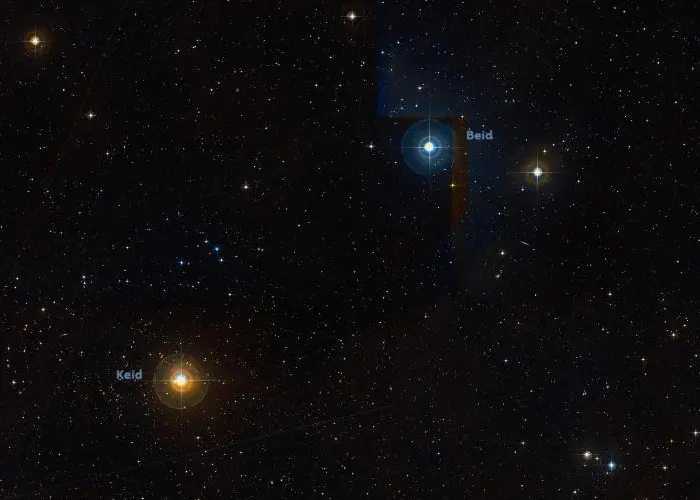
Keid and Beid (40 and 38 Eridani), image: Wikisky
The components 40 Eridani B and C were discovered by the German-born English astronomer William Herschel on January 31, 1783. They were listed in Herschel’s VI. Catalogue of double stars, published in January 1785.
The companions were later observed by the Baltic German astronomer Friedrich Struve in 1825 and by his son Otto Struve in 1851. F. Struve estimated the third component to be on the line connecting components A and B.
40 Eridani B was the first white dwarf ever discovered and the easiest white dwarf to observe. In 1910, it was found to be white in colour, indicating that it was a small star. The Scottish astronomer Williamina Fleming and American astronomers Henry Norris Russell and Edward Charles Pickering found it to be of spectral type A.
In the June 1944 issue of The Astronomical Journal, Russell noted, “The first person who knew of the existence of white dwarfs was Mrs. Fleming; the next two, an hour or two later, Professor E. C. Pickering and I. With characteristic generosity, Pickering had volunteered to have the spectra of the stars which I had observed for parallax looked up on the Harvard plates. All those of faint absolute magnitude turned out to be of class G or later. Moved with curiosity I asked him about the companion of 40 Eridani. Characteristically, again, he telephoned to Mrs. Fleming who reported within an hour or so, that it was of Class A. I saw enough of the physical implications of this to be puzzled, and expressed some concern. Pickering smiled and said, ‘It is just such discrepancies which lead to the increase of our knowledge.’”
Even though it is neither the brightest nor the closest white dwarf to Earth, 40 Eridani B is easier to observe than the white dwarfs in the Sirius and Procyon systems. The companions of Sirius and Procyon are challenging targets because they are engulfed in the glare of their brighter companions. Van Maanen’s Star, the closest solitary white dwarf to the solar system, is almost three magnitudes fainter than 40 Eridani B. It lies 14.072 light-years from the Sun in the constellation Pisces and has an apparent magnitude of 12.374.
Name
The name Keid (pronunciation: /ˈkaɪd/) comes from the Arabic word alqayḍ, meaning “the eggshells.” The name also alludes to Beid (Omicron1 Eridani), whose name is derived from the Arabic bayḍ, meaning “the egg” or “eggs.”
The name Keid was approved by the International Astronomical Union’s (IAU) Working Group on Star Names (WGSN) on September 12, 2016. It formally applies only to the component Omicron2 Eridani A (40 Eridani A) but has been commonly used for the whole 40 Eridani system.
The star system is commonly referred to by its Flamsteed designation 40 Eridani and by the Bayer designation Omicron2 Eridani. The component 40 Eridani C also has the variable star designation DY Eridani.
Location
40 Eridani is not too difficult to find but it requires good conditions because it is relatively faint. The star and its neighbour Beid are part of the stream in the constellation figure of the celestial River (Eridanus).
Keid appears along the imaginary line extended from Cursa (Beta Eridani) to Rana (Delta Eridani) just south of the line extended from Saiph (Kappa Orionis) through Rigel (Beta Orionis). Keid and the brighter Beid (38 Eridani) are the brightest points of light in this part of the sky. Like Ran (Epsilon Eridani) and Rana (Delta Eridani), they form a visual pair.
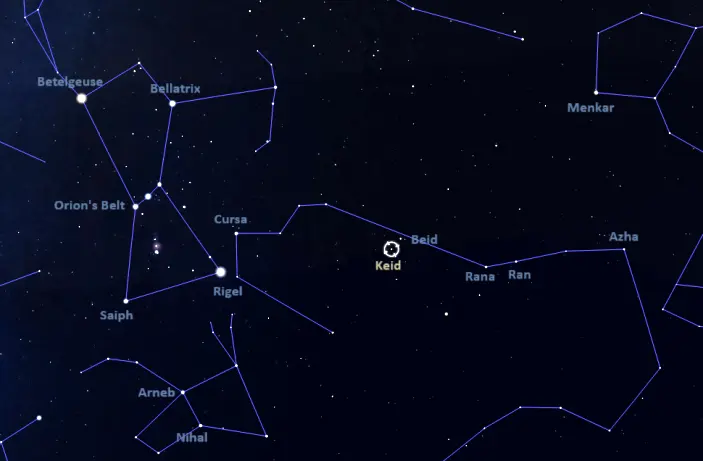
The location of 40 Eridani (Keid), image: Stellarium
Constellation
40 Eridani lies in the constellation of Eridanus. Representing the celestial River, Eridanus stretches farther from north to south than any other constellation. Its northernmost end lies near Rigel at the foot of Orion and the southern end is marked by Achernar in the far southern sky.
Eridanus is one of the 48 Greek constellations catalogued by the Greco-Roman astronomer Claudius Ptolemy of Alexandria in the 2nd century CE. In Greek mythology, the constellation is associated with the myth of Phaëthon, the son of the Sun god Helios, who lost control of his father’s chariot and fell into a river.
Eridanus stretches across 1138 degrees of the mostly southern sky and is the sixth largest of the 88 constellations. It is one of the 15 equatorial constellations, and its northern part is visible from most locations for at least part of the year.
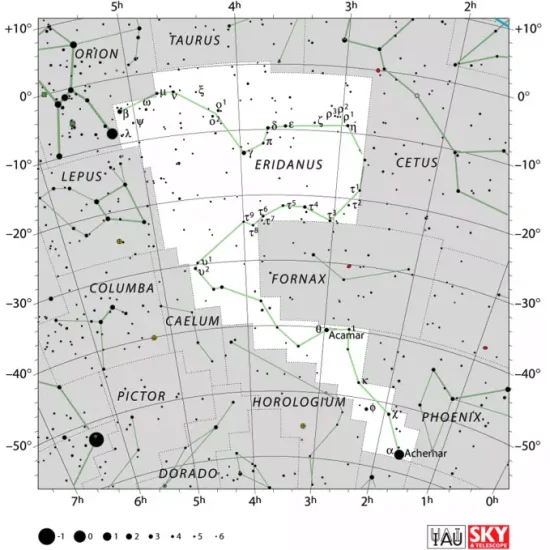
Eridanus constellation map by IAU and Sky&Telescope magazine
Eridanus is best-known for hosting Achernar, the ninth brightest star in the sky, and the K-type main sequence star Epsilon Eridani, the 12th individual closest star to the Sun. Formally known as Ran, Epsilon Eridani is the third nearest star to Earth that can be seen without binoculars, after Alpha Centauri and Sirius.
Eridanus is also home to the A-type giant Cursa (Beta Eridani), the variable red giant Zaurak (Gamma Eridani), the orange subgiant Rana (Delta Eridani), the orange giant Angetenar (Tau2 Eridani), the binary system Acamar (Theta Eridani), and the solar twin 82 G. Eridani, which hosts at least three planets.
Notable deep sky objects in Eridanus include the reflection nebula IC 2118 (the Witch Head Nebula) near Rigel in Orion, the planetary nebula NGC 1535, the ring galaxy NGC 1291, and the grand design barred spiral galaxy NGC 1300. The constellation also hosts the WMAP Cold Spot (Eridanus Supervoid), a vast region devoid of galaxies.
The best time of the year to observe the stars and deep sky objects in Eridanus is during the month of December, when the constellation climbs higher above the horizon in the evening. The entire constellation is visible from locations south of the latitude 32° N.
The 10 brightest stars in Eridanus are Achernar (Alpha Eri, mag. 0.40 – 0.46), Cursa (Beta Eri, mag. 2.796), Acamar (Theta1 Eri, mag. 2.88), Zaurak (Gamma Eri, mag. 2.88 – 2.96), Rana (Delta Eri, mag. 3.51 – 3.56), Upsilon4 Eridani (mag. 3.55), Phi Eridani (mag. 3.55), Chi Eridani (3.70), Tau4 Eridani (mag. 3.57 – 3.72), and Ran (Epsilon Eri, mag. 3.736).
40 Eridani
| Spectral type | K0.5V + DA4 + M4.5eV |
| Constellation | Eridanus |
| Names and designations | Omicron2 Eridani, ο2 Eri, 40 Eridani, 40 Eri, GJ 166, ADS 3093, CCDM J04153-0739 |
40 Eridani A
| Spectral class | K0.5V |
| U-B colour index | +0.45 |
| B-V colour index | +0.82 |
| Apparent magnitude | 4.43 |
| Absolute magnitude | 5.93 |
| Distance | 16.340 ± 0.010 light-years (5.010 ± 0.003 parsecs) |
| Parallax | 199.6080 ± 0.1208 mas |
| Radial velocity | −42.47 ± 0.12 km/s |
| Proper motion | RA: −2,240.085 ± 0.135 mas/yr |
| Dec.: −3,421.809 ± 0.094 mas/yr | |
| Mass | 0.78 ± 0.08 M☉ |
| Luminosity | 0.457 ± 0.002 L☉ |
| Radius | 0.812 ± 0.017 R☉ |
| Temperature | 5,072 ± 53 K |
| Metallicity | −0.42 ± 0.04 dex |
| Age | 6.9 ± 4.7 billion years |
| Rotational velocity | 1.23 ± 0.28 km/s |
| Rotation | ~37–43 days |
| Surface gravity | 4.45 ± 0.19 cgs |
| Right ascension | 04h 15m 16.3196189945s |
| Declination | −07° 39′ 10.330779018″ |
| Names and designations | Keid, Omicron2 Eridani A, 40 Eridani A, 40 Eri A, BD−07° 780, HD 26965, HR 1325, HIP 19849, SAO 131063, LTT 1907, NLTT 12863, LHS 23, GC 5138, GCRV 2440, PPM 400061, PLX 945, UBV 4139, 2MASS J04151651-0739068, TYC 5312-2325-1, Gaia DR2 3195919528988725120, Gaia DR2 3195919528988725120, AAVSO 0410-07, ADS 3093 A, CCDM J04153-0739A, WDS J04153-0739A |
40 Eridani B
| Spectral class | DA4 or DA2.9 |
| U-B colour index | +0.45 |
| B-V colour index | +0.03 |
| Apparent magnitude | 9.52 |
| Distance | 16.333 ± 0.004 light-years (5.008 ± 0.001 parsecs) |
| Parallax | 199.6911 ± 0.0512 mas |
| Radial velocity | -21 ± 10 km/s |
| Proper motion | RA: −2,236.169 ± 0.048 mas/yr |
| Dec.: −3,338.955 ± 0.039 mas/yr | |
| Mass | 0.573 ± 0.018 M☉ |
| Luminosity | 0.013 L☉ |
| Radius | 0.014 R☉ |
| Temperature | 16,500 K |
| Age | 1.8 billion years |
| Right ascension | 04h 15m 21.7957181469s |
| Declination | −07° 39′ 29.203986789″ |
| Names and designations | Omicron2 Eridani B, 40 Eridani B, 40 Eri B, HD 26976, SAO 131065, BD−07° 781, LTT 1908, NLTT 12868, LHS 24, G 160-060, GC 5140, GCRV 2441, 2MASS J04152196-0739254, UBV 4141, WD 0413-07, WD 0413-077, WD 0413-074, Gaia DR2 3195919254110817408, Gaia DR3 3195919254111315712, ADS 3093 B, CCDM J04153-0739B, WDS J04153-0739B |
40 Eridani C
| Spectral class | M4.5eV |
| Variable type | Flare star |
| U-B colour index | +0.83 |
| B-V colour index | +1.67 |
| Apparent magnitude | 11.17 |
| Distance | 16.353 ± 0.006 light-years (5.014 ± 0.002 parsecs) |
| Parallax | 199.4516 ± 0.0692 mas |
| Radial velocity | −44.06 ± 0.20 km/s |
| Proper motion | RA: −2,247.183 ± 0.065 mas/yr |
| Dec.: −3,409.824 ± 0.054 mas/yr | |
| Mass | 0.2036 ± 0.0064 M☉ |
| Luminosity | 0.008 L☉ |
| Radius | 0.31 R☉ |
| Temperature | 3,100 K |
| Age | 5.6 billion years |
| Right ascension | 04h 15m 21.5359980886s |
| Declination | −07° 39′ 20.694578096″ |
| Names and designations | Omicron2 Eridani C, 40 Eridani C, 40 Eri C, DY Eridani, DY Eri, BD−07°781 C, LHS 25, LTT 1909, NLTT 12869, GCRV 2442, 2MASS J04152173-0739173, UBV 4142, Gaia DR2 3195919322830293760, Gaia DR3 3195919254111314816, ADS 3093 C, CCDM J04153-0739C, WDS J04153-0739C |